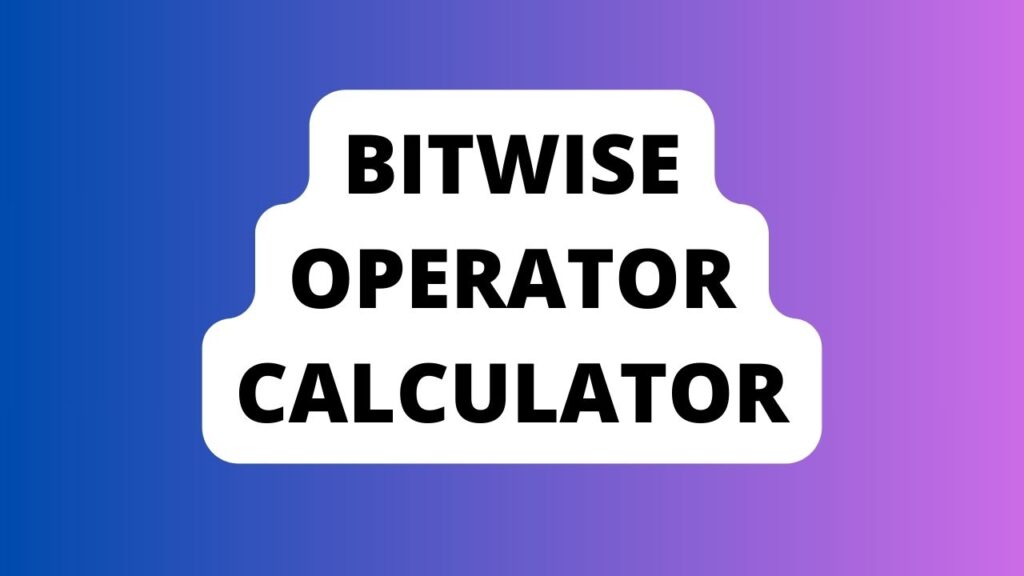Introduction to Bitwise Operators
Bitwise Operator Calculator Bitwise operators are fundamental tools in programming that manipulate individual bits of data. They perform operations at the binary level, working with bits ‘0’ and ‘1’. Understanding these operators is crucial as they form the building blocks for more complex operations in programming languages.
What are Bitwise Operators?
At their core, bitwise operators are symbols used to perform operations at the binary level. These operations include AND, OR, XOR, and shifts (left and right). Each operator handles bits in different ways, enabling programmers to perform specific tasks efficiently.
Importance in Programming Languages
Bitwise operations are integral to programming languages like C, C++, Python, and more. They allow for low-level manipulation of data, making them essential in tasks involving device drivers, cryptography, data compression, and network communications.
Understanding Binary Operations
To comprehend bitwise operators, one needs to grasp binary arithmetic. Binary involves only two digits, 0 and 1, representing OFF and ON states, respectively. Bitwise operators perform logical operations on these binary digits, aiding in data manipulation.
Stay tuned as we delve deeper into the various types of bitwise operators and their applications in programming languages!
Types of Bitwise Operators
Bitwise operators encompass two primary categories: logical operators and shift operators, each serving distinct purposes in manipulating binary data.
Logical Operators
1. AND (&)
The AND operator, denoted by ‘&’, compares corresponding bits of two operands. It returns ‘1’ if both bits are ‘1’; otherwise, it results in ‘0’. This operator is valuable in setting or clearing specific bits in binary data.
2. OR (|)
The OR operator, symbolized by ‘|’, compares corresponding bits of two operands. It returns ‘1’ if either of the bits is ‘1’, resulting in ‘0’ only when both bits are ‘0’. This operator aids in combining sets of bits.
3. XOR (^)
The XOR operator, represented by ‘^’, compares corresponding bits of two operands. It returns ‘1’ if the bits are different (‘0’ and ‘1’ or ‘1’ and ‘0’), otherwise ‘0’. This operator is used in toggling bits.
Shift Operators
1. Left Shift (<<)
The left shift operator, ‘<<‘, moves the bits of a binary number to the left by a specified number of positions. This operation effectively multiplies the number by 2 for each shift left.
2. Right Shift (>>)
The right shift operator, ‘>>’, moves the bits of a binary number to the right by a specified number of positions. This operation effectively divides the number by 2 for each shift right.
Understanding the functionality and application of these operators lays the groundwork for efficient data manipulation in programming. Next, we’ll explore how bitwise operators are practically employed in various scenarios!

Use Cases of Bitwise Operators
Bitwise operators find extensive application across diverse domains within the realm of programming. Understanding these practical use cases sheds light on their significance in real-world scenarios.
Application in Conditional Statements
Bitwise operators are often utilized in conditional statements to efficiently check and modify specific bits. For instance, using bitwise AND (&) to determine if a particular bit is set or using OR (|) to set specific bits based on conditions.
Masking Techniques
One prevalent use of bitwise operators is in masking techniques. By applying masks using AND (&) or OR (|) operations, programmers can extract or modify specific bits within a binary number, enabling precise control over data.
Cryptography and Security
Bitwise operators play a vital role in cryptographic algorithms and security protocols. They are instrumental in encryption, decryption, and authentication processes by manipulating bits to ensure data confidentiality and integrity.
The versatility of bitwise operators extends their functionality beyond these examples, impacting various aspects of programming and computational tasks. In the next section, we’ll delve into the specifics of a Bitwise Operator Calculator, exploring its features and functionalities.
